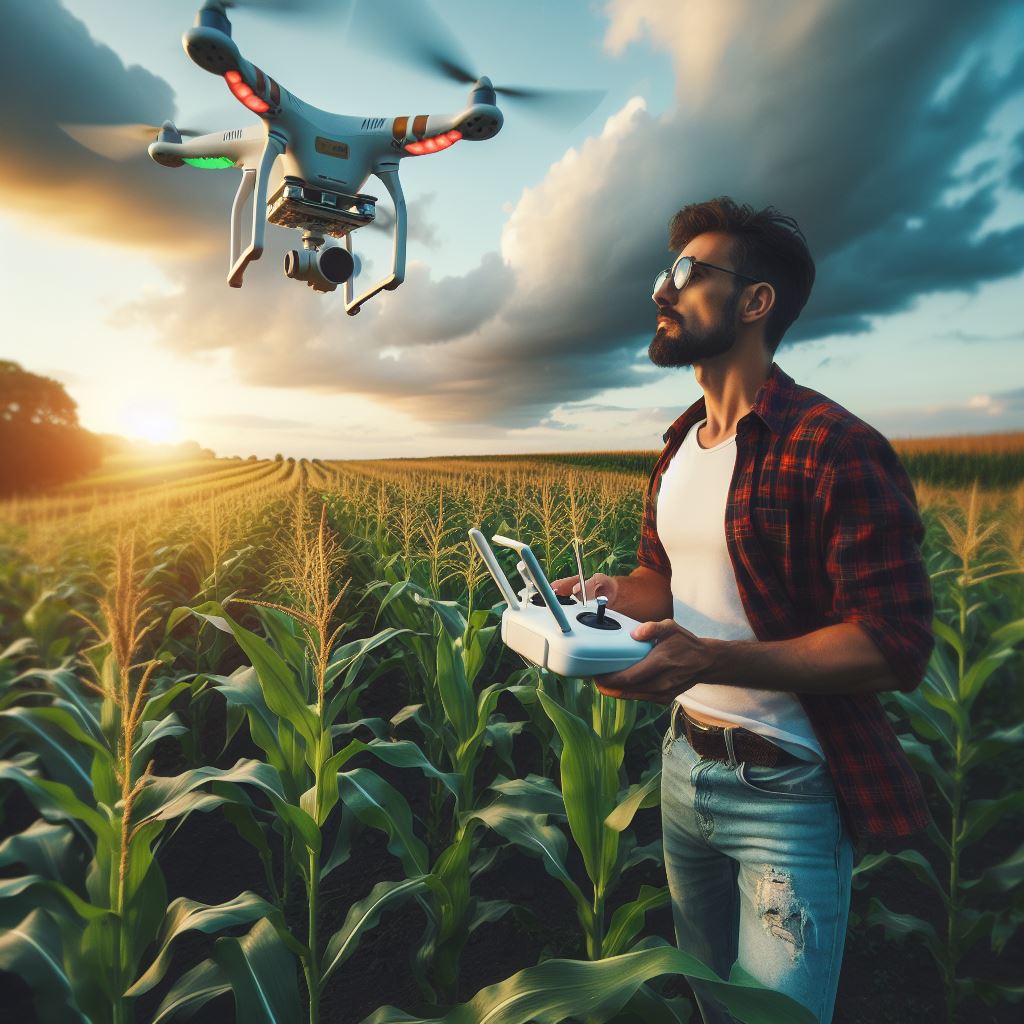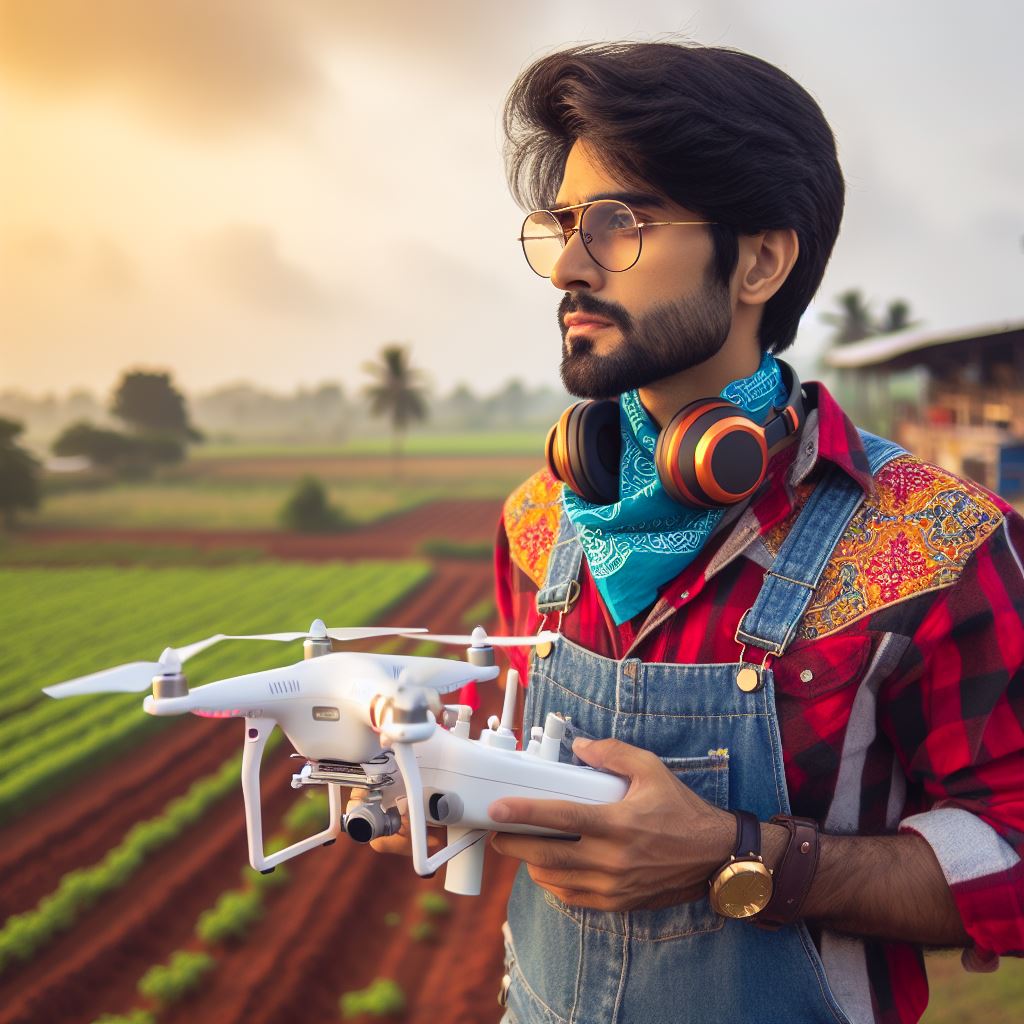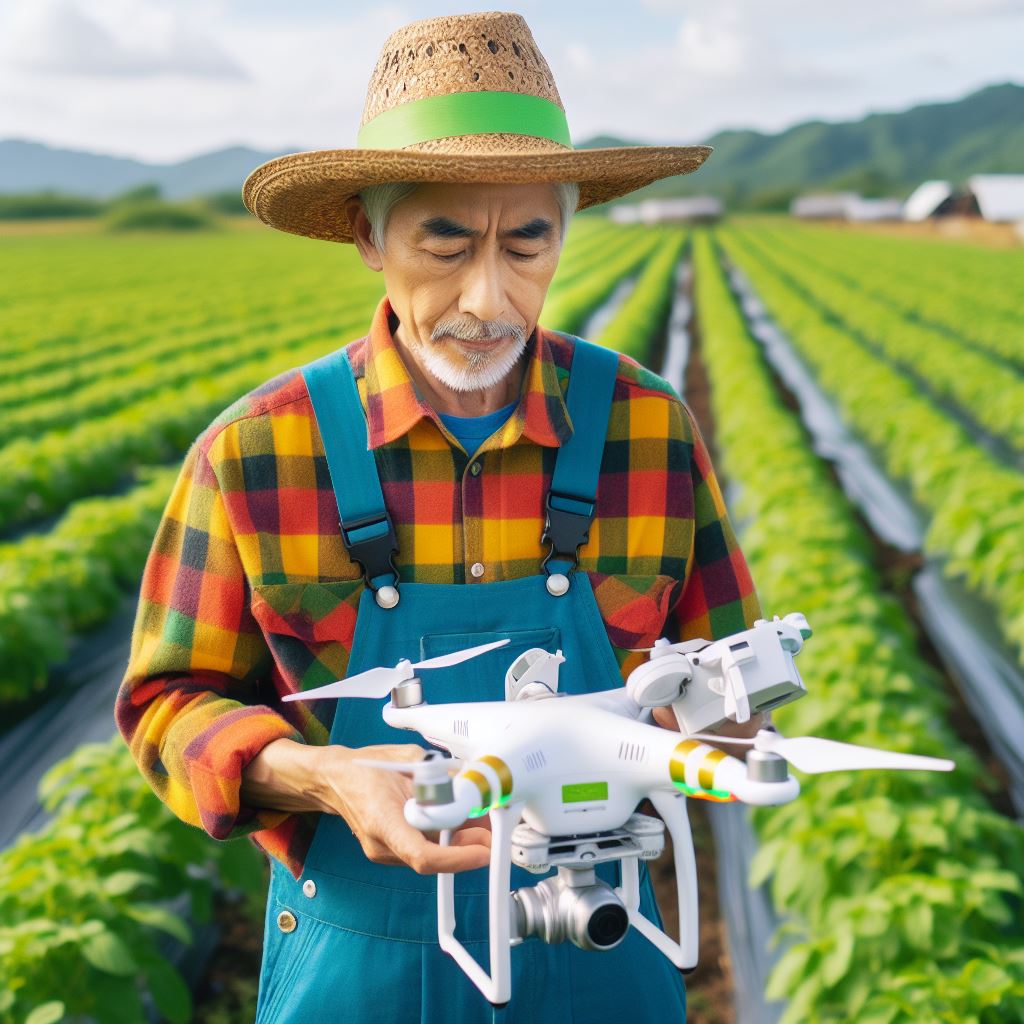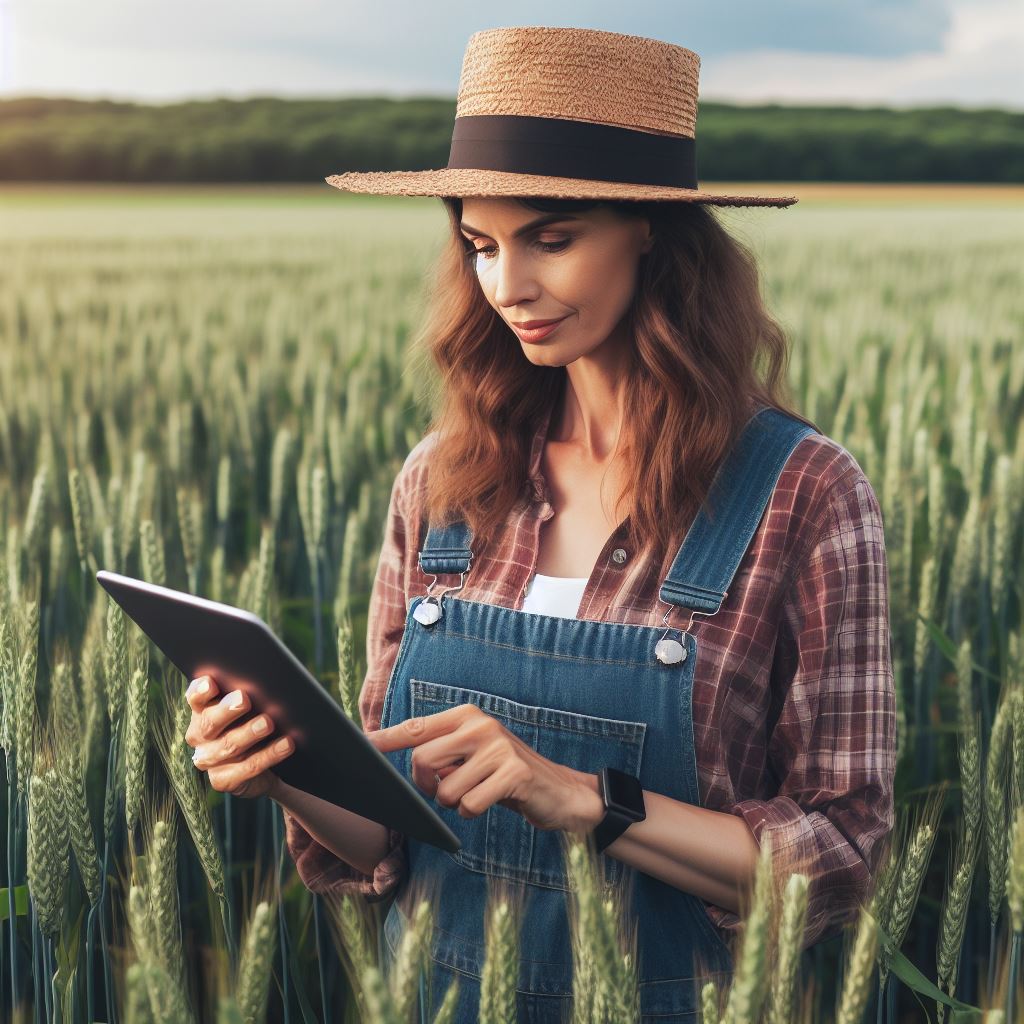Introduction
Brief overview of aerial farming and the use of drones
Aerial farming, also known as precision agriculture, is the practice of using drones for farming purposes.
Drones have become key tools in this field due to their importance in various farming activities.
Drones offer a wide range of benefits in aerial farming.
They are used for tasks such as crop monitoring, spraying, and seed planting.
With their advanced sensors and cameras, drones provide valuable data for farmers to make informed decisions.
Importance of drones as key tools in aerial farming
One of the key reasons why drones are vital in aerial farming is their ability to provide real-time data.
They can capture high-resolution images, helping farmers detect crop health issues, pest infestations, and irrigation problems.
Moreover, drones can cover large agricultural areas efficiently and quickly.
They can fly over fields, capturing detailed data and images without the need for human intervention.
This saves farmers time and effort while ensuring accurate information.
Additionally, drones enable farmers to reduce costs and increase productivity.
By identifying specific areas that require attention, farmers can target their efforts and resources effectively.
This leads to improved crop yields and overall profitability.
The use of drones in aerial farming also promotes sustainability.
By employing precision agriculture techniques, farmers can optimize water usage, minimize chemical applications, and reduce environmental impact.
Transform Your Agribusiness
Unlock your farm's potential with expert advice tailored to your needs. Get actionable steps that drive real results.
Get StartedBasically, drones play a crucial role in aerial farming.
Their ability to provide real-time data, cover large areas, and enhance productivity make them indispensable tools for modern farming practices.
As technology continues to advance, drones will revolutionize the agriculture industry, ensuring efficient and sustainable food production.
Benefits of Using Drones in Aerial Farming
Using drones in aerial farming offers numerous benefits, revolutionizing the way agriculture is practiced.
Let’s explore some of the advantages in detail.
Improved Efficiency
One major advantage of using drones in aerial farming is the improved efficiency it brings to the agricultural process.
Drones equipped with various sensors and cameras can cover large areas quickly and gather crucial data.
This data can then be utilized by farmers to make informed decisions regarding irrigation, fertilization, and pest control.
With real-time information, farmers can monitor their crops more efficiently, ensuring timely interventions and minimizing potential risks.
Furthermore, drones enable the implementation of precision agriculture techniques.
By utilizing detailed imagery and data obtained from drones, farmers can identify specific areas of their fields that require attention.
This allows for targeted spraying of pesticides or fertilizers, reducing the overall use of chemicals and optimizing their effectiveness.
The ability to precisely monitor crop health and growth patterns can help farmers make adjustments accordingly, leading to better overall crop production.
Cost-effectiveness
In addition to boosting efficiencies, drones also offer significant cost savings for farmers.
One major area where cost-effectiveness is realized is in labor costs.
Drones eliminate the need for extensive manual labor in monitoring and inspecting fields, which can be time-consuming and expensive.
With drones, farmers can remotely monitor their crops and quickly identify any issues, reducing the dependence on manual labor.
Moreover, drones help improve crop yields while reducing input wastage.
By providing detailed and accurate information on crop health, drones enable farmers to apply fertilizers and pesticides only where they are needed, optimizing their usage.
This targeted approach reduces both the cost of inputs and the potential environmental impact.
Additionally, drones can identify areas of the field that may require additional irrigation or other types of intervention, ensuring resources are used efficiently and effectively.
Access to Challenging Locations
Drones have the ability to access challenging and hard-to-reach locations that may be inaccessible or hazardous for humans.
For example, drones can navigate dense vegetation, fly over water bodies, or reach areas with difficult terrain.
This allows farmers to monitor and manage crops in areas that would otherwise be difficult or dangerous to access.
Showcase Your Farming Business
Publish your professional farming services profile on our blog for a one-time fee of $200 and reach a dedicated audience of farmers and agribusiness owners.
Publish Your ProfileDrones are especially useful in mountainous regions or fields with uneven terrains, where traditional machinery may be limited.
Essentially, the use of drones in aerial farming offers significant benefits.
Improved efficiency, cost-effectiveness, and access to challenging locations are just a few advantages of using drones in agriculture.
With advancements in drone technology and a greater understanding of their potential, the future of aerial farming looks promising.
Read: Precision Agriculture: How Drones Change the Game
Applications of Drones in Aerial Farming
Drones have emerged as key tools in aerial farming, revolutionizing the way agriculture is practiced.
Their versatile applications have proven to be immensely beneficial for crop monitoring, irrigation management, mapping, and analysis.
Crop Monitoring and Management
One of the primary uses of drones in aerial farming is crop monitoring and management.
Through real-time monitoring, drones enable farmers to keep a close eye on the health of their crops.
By identifying early signs of stress or nutrient deficiencies, they can take immediate action to rectify the situation.
Additionally, drones equipped with sensors and imaging technology can detect diseases or pests at their early stages, allowing farmers to implement timely measures for control or prevention.
Moreover, the precision agriculture techniques employed by drones ensure that fertilizers and pesticides are applied precisely, minimizing wastage and reducing environmental impact.
Irrigation Management
Irrigation management is another crucial aspect where drones play a significant role.
By analyzing crop moisture levels and soil conditions, drones efficiently determine the water requirements of plants.
This information assists farmers in optimizing their irrigation practices.
Moreover, drones enable the monitoring of soil moisture, thereby preventing over or under watering, which can have detrimental effects on crop growth and yield.
The precise irrigation facilitated by drones ensures that crops receive adequate hydration, leading to improved productivity.
Mapping and Analysis
Drones also contribute to mapping and analysis in aerial farming.
Aerial mapping of fields using drones provides farmers with a bird’s eye view of their land, allowing them to plan and manage their resources effectively.
By collecting data such as plant health, topography, and vegetation indices, drones empower farmers to make informed decisions regarding crop cultivation and management.
Additionally, the data collected by drones can be utilized for yield estimation and analysis, aiding in the prediction of harvest volumes and overall farm productivity.
It enables farmers to assess their farming practices and identify opportunities for optimization and improvement.
In general, the applications of drones in aerial farming are diverse and extensive.
From crop monitoring and management to irrigation optimization and mapping, drones have proven to be vital tools for modern agriculture.
The ability to monitor crop health in real-time, detect diseases or pests, and precisely apply fertilizers or pesticides contributes to sustainable and efficient farming practices.
Furthermore, drones aid in water conservation by determining water requirements accurately and preventing wasteful irrigation practices.
Finally, the mapping and analysis capabilities of drones provide farmers with valuable insights to improve their planning and decision-making processes.
As technology advances, the potential for drones in aerial farming continues to expand, promising a more productive and sustainable future for agriculture.
Read: Drones in Agriculture: The Future of Farming
Challenges and Limitations of Aerial Farming with Drones
Despite the promising potential of aerial farming with drones, there are several challenges and limitations that need to be overcome for the widespread adoption of this technology in agriculture.
Regulatory and Legal Issues
One of the primary challenges faced by farmers and drone operators is ensuring compliance with aviation regulations.
Drones are aircraft, and therefore, they need to adhere to specific rules and restrictions set by aviation authorities.
This includes obtaining the necessary permits and certifications, registering the drones, and following operational guidelines.
Privacy concerns and restrictions are also emerging as critical issues related to the use of drones in agriculture.
Drones equipped with cameras and sensors can collect vast amounts of data, including visual images and environmental information.
However, the collection and use of such data raise privacy concerns among individuals and communities.
Regulations must be in place to address these concerns and protect the privacy of individuals while utilizing drones for aerial farming.
Technical Limitations
Although drones offer numerous advantages for aerial farming, they have some inherent technical limitations.
Limited flight time and payload capacity restrict the amount of ground a drone can cover and the weight it can carry.
This becomes a challenge, especially when addressing large-scale farming operations that require extended flight durations and heavy payloads.
Showcase Your Farming Business
Publish your professional farming services profile on our blog for a one-time fee of $200 and reach a dedicated audience of farmers and agribusiness owners.
Publish Your ProfileFurthermore, weather conditions have a significant impact on drone operations.
Strong winds, heavy rain, or extreme temperatures can make it unsafe or impossible for drones to fly.
These environmental factors affect the efficiency and reliability of aerial farming with drones, making it necessary to consider weather conditions before launching drone operations.
The accuracy and reliability of the data collected by drones are crucial for making informed decisions in farming activities.
However, ensuring the precision and consistency of data collected by drones can be challenging.
Factors such as sensor calibration, technical malfunctions, or limitations in data transmission can lead to inaccuracies or inconsistencies in the information collected.
Overcoming these challenges is essential to maximize the value and usability of drone-collected data.
Initial Investment and Training
The initial investment required for adopting aerial farming with drones can be substantial.
Acquiring the necessary drones, sensors, and software, as well as ensuring their proper maintenance, adds financial burden to farmers.
Additionally, training personnel to operate and maintain drones requires time, effort, and resources.
Farmers must invest in workshops and training programs to equip their workforce with the necessary skills and knowledge to effectively use drones in farming operations.
In essence, while aerial farming with drones offers immense potential, several challenges and limitations need to be addressed.
Regulatory and legal issues, including compliance with aviation regulations and privacy concerns, must be resolved.
Technical limitations related to flight time, payload capacity, and data accuracy need to be overcome.
Moreover, the initial investment and training required for adopting this technology should not be underestimated.
By actively addressing these challenges, the agricultural industry can unlock the full benefits of aerial farming with drones.
Read: Revolutionizing Farms: Drones in Crop Monitoring
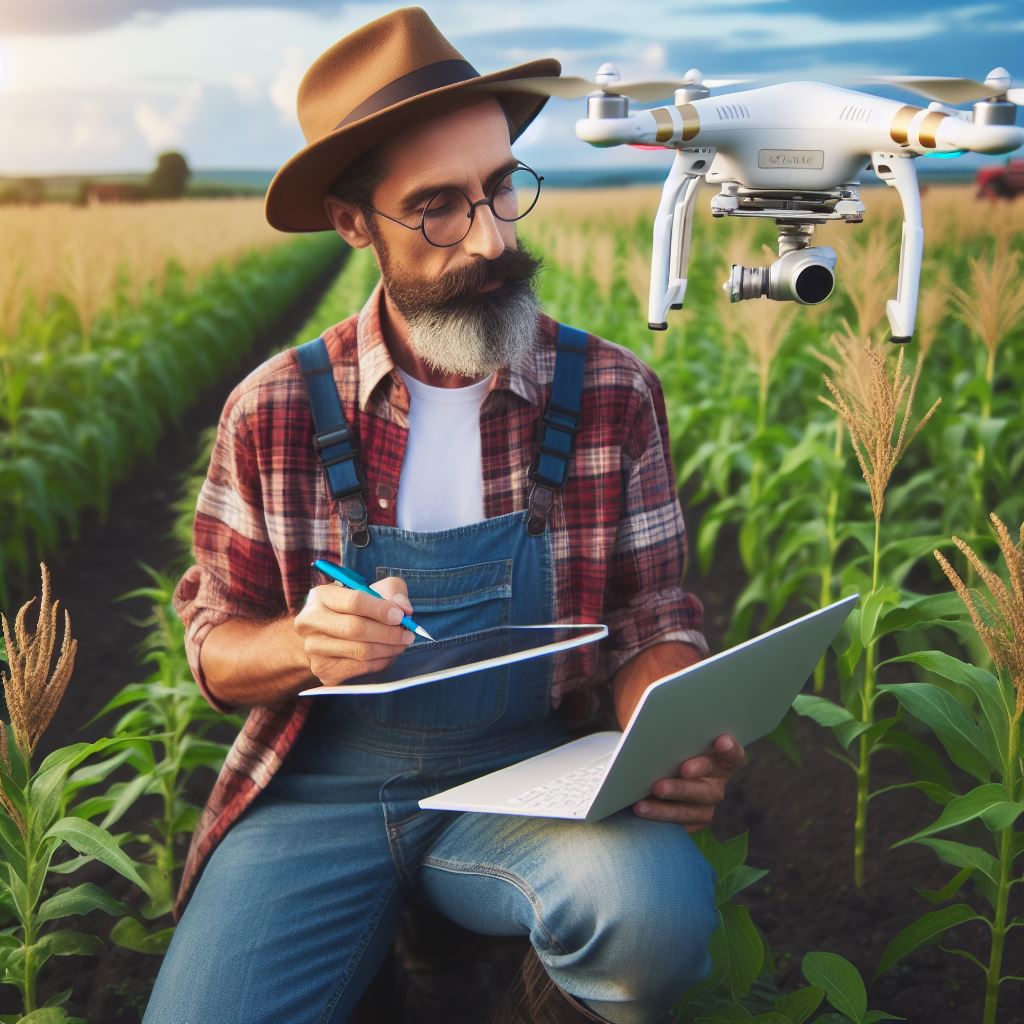
Future Trends and Innovations in Aerial Farming with Drones
The future holds immense potential for aerial farming with the integration of drones.
As advancements in drone technology continue to emerge, the benefits are set to revolutionize the agricultural industry.
Advancements in Drone Technology
Longer flight endurance and improved battery life
- One of the main challenges faced by drones is limited flight time due to battery life constraints. Future drone technology aims to address this issue by enhancing flight endurance capabilities, allowing drones to stay in the air for longer durations.
- Improved battery life will provide farmers with increased efficiency and productivity in aerial farming operations. Drones will be able to cover larger areas and perform multiple tasks without the need for frequent recharging.
Enhanced payload capacity and data collection capabilities
- Future drones will have increased payload capacity, enabling them to carry heavier loads. This will allow for the transportation of more advanced equipment and sensors, expanding the capabilities of aerial farming.
- Improved data collection systems will also be integrated into drones. High-resolution imaging, multispectral sensors, and additional monitoring devices will provide farmers with detailed information about crop health, soil conditions, and other important data points to improve decision-making in farming operations.
Artificial Intelligence and Machine Learning Integration
Autonomous decision-making capabilities for drones
- With the integration of artificial intelligence, drones will possess the ability to make autonomous decisions during flight, enhancing their overall performance.
- This technology will enable drones to adapt to changing environmental conditions, optimize flight routes, and autonomously avoid obstacles, ensuring safer and more efficient operations.
Improved data analysis and crop predictions
- Machine learning algorithms will be integrated with drone data, allowing for improved data analysis and interpretation.
- By analyzing vast amounts of data collected by drones, machine learning algorithms will provide accurate predictions about crop yields, disease outbreaks, and pest infestations. This will enable farmers to take proactive measures, resulting in better crop management and higher yields.
Collaboration with Other Technologies
Integration of drones with satellite imagery and sensors
- Drones will collaborate with satellite imagery to provide a comprehensive view of agricultural lands. This integration will combine the advantages of both technologies, enabling farmers to monitor large areas and gain valuable insights into crop health and resource management.
- Sensors will also be integrated with drones to collect real-time data on weather conditions, soil moisture, and nutrient levels. Combined with satellite imagery, this data will help optimize irrigation scheduling, fertilizer application, and overall resource allocation.
Utilizing data from Internet of Things (IoT) devices
- The Internet of Things (IoT) will play a crucial role in the future of aerial farming. Drones will communicate with IoT devices, such as weather stations and soil sensors, to gather real-time data for enhanced decision-making.
- This integration will enable farmers to have a holistic understanding of their fields, as data from IoT devices will complement drone-collected information. The synergy between drones and IoT devices will lead to more efficient and precise farming practices.
In a nutshell, the future of aerial farming with drones holds immense potential for revolutionizing the agricultural industry.
Advancements in drone technology, integration of artificial intelligence and machine learning, and collaboration with other technologies will pave the way for more efficient and sustainable farming practices.
With drones as key tools, farmers will be empowered to make data-driven decisions, resulting in increased productivity, reduced costs, and improved overall agricultural outcomes.
Read: Drones in Agri: Irrigation Game Changer
Conclusion
Recap of the significance of drones in aerial farming
As explored throughout this article, drones are integral to establishing and managing aerial agriculture systems, from construction to planting to ongoing maintenance.
Equipped with cameras, sensors, robotic arms and more, drones uniquely enable hands-off farming in the air to address land constraints.
Drones provide aerial imagery for site selection, lift and assemble structural components, embed growing media efficiently, transport seedlings gently, and continually monitor crop health.
Summary of benefits and applications
Allowing substantial yields on small footprints, vertical farms and other creative agriculture systems rely extensively on agile, high-functioning drones.
Drones minimize labor requirements while optimizing crops through precise data inputs.
With global populations expanding amidst finite ground farmland, specialized drones keep agricultural production aligned with demand growth through revolutionary farming methods not otherwise possible.
Anticipation of future advancements in the field
Given accelerating climate change and urbanization straining traditional farming models, aerial agriculture supported by drones has become essential for future food security.
Ongoing innovations will further integrate automation from seed to harvest using improved camera sensors, manipulator arms, and self-navigational AI.
Drones will soon conduct real-time analytics of crop needs to adjust inputs for optimal yields.
By enabling agriculture to transcend land and climate constraints, drones will play an integral role in sustainably, efficiently nourishing the world.
The future of food depends mightily on drones and the budding aerial farming sector their capabilities empower.

